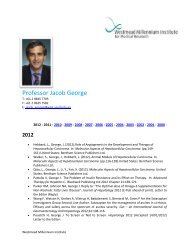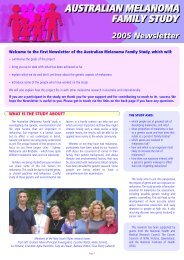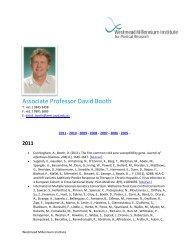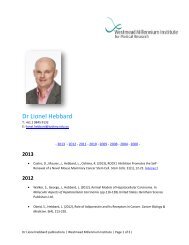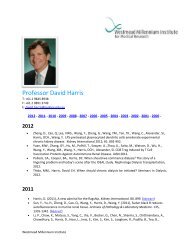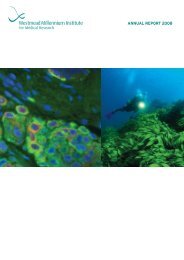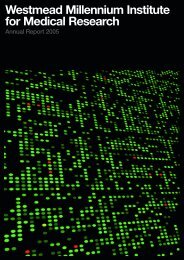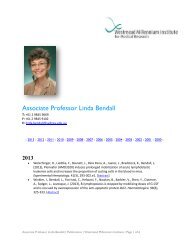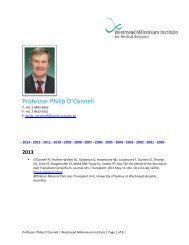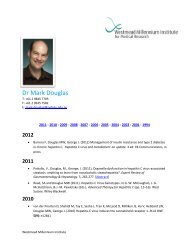Translating >> - Westmead Millennium Institute
Translating >> - Westmead Millennium Institute
Translating >> - Westmead Millennium Institute
- No tags were found...
You also want an ePaper? Increase the reach of your titles
YUMPU automatically turns print PDFs into web optimized ePapers that Google loves.
38 39 > Research Report // AR 2006<br />
0.005.0484<br />
0.005.0486 research facilities 00.005.0459 at <strong>Westmead</strong>. The Bank 00.005.0458<br />
was created to<br />
provide a resource of breast cancer biospecimens and clinical<br />
46<br />
0.005.0489<br />
26<br />
The mechanisms through which PR controls gene expression<br />
have also been explored in 2006, with the demonstration<br />
that receptors aggregate with other key components of<br />
transcriptional machinery when they are activated. Studies in<br />
2006 demonstrated that these aggregations were functionally<br />
significant, and identified some of the key functional<br />
components of these aggregates. This aggregation process<br />
is disrupted in human cancers, and ongoing studies in the<br />
group are aimed at identifying the functional consequences<br />
of its disruption in cancer. Most breast cancers are thought to<br />
be initiated at puberty, and develop throughout reproductive<br />
life. Although the vast majority of breast cancers are detected<br />
after menopause, the influence of cyclical ovarian hormones<br />
on their biology is profound. The studies from the Breast<br />
Cancer Group aim to throw new light on the fundamental<br />
question of how ovarian hormones influence breast cancer<br />
initiation and progression.<br />
Breast cancer tissue bank<br />
WMI has led the establishment of the Breast Cancer Tissue<br />
Bank with funding from the NHMRC, Cancer <strong>Institute</strong><br />
NSW and the National Breast Cancer Foundation. The<br />
headquarters of the Bank are located within the clinical and<br />
data to support breast cancer research throughout Australia.<br />
Under the management of WMI a network of centres from<br />
across New South Wales collected tissue for the Bank during<br />
2006.<br />
Materials in the bank are processed and stored using<br />
international best practice methodologies to preserve the<br />
integrity of the specimens and increase their value to research<br />
scientists. Access to human tissue is essential for translating<br />
00.005.0463<br />
46<br />
00.005.0482 00.005.0481<br />
00.005.0465 00.005.0466<br />
51<br />
00.005.0462<br />
has important implications for determining the risk of genetic-epidemiological studies investigating the familial<br />
developing melanoma and possibly the treatment strategy aspects of cancer. As many high-risk individuals have now<br />
for patients carrying altered copies of the p16INK4a protein. been identified, the group established a risk-management<br />
Furthermore, it is likely that unidentified p16INK4a clinic in 2006 that facilitates co-ordinated, multidisciplinary<br />
functions (other then regulation of cell proliferation) may care of women at high risk of breast and ovarian cancer, as<br />
add to its role as melanoma susceptibility gene. The Cell well as providing further opportunities for research. The<br />
Cycle research group is investigating the role of p16INK4a in study of Magnetic Resonance Imaging of the breasts of highrisk<br />
women in NSW has commenced at <strong>Westmead</strong> and the<br />
novel biomolecular pathways.<br />
group is now accumulating data to determine its usefulness<br />
The BRAF oncogene is switched on in most melanomas<br />
in comparison to standard mammographic screening. The<br />
but intriguingly also in 80% of benign moles. Most moles<br />
Service has completed the collaborative study of breast ductal<br />
never transform into melanomas and their melanocytes are<br />
lavage specimens, investigating its use as a surveillance tool in<br />
normally growth arrested. Thus, although aberrant activation<br />
women at high risk of breast cancer.<br />
of BRAF plays a role in melanoma, normal melanocytes<br />
apparently respond to active BRAF by growth arrest and The group continues to participate in the international<br />
only additional genetic alterations allow these cells to become GOG-199 study, aimed at assessing the usefulness of<br />
malignant. The Cell Cycle research group is exploring the screening versus preventive surgery in women at increased<br />
mechanisms responsible for this BRAF-induced growth risk of cancer of the ovary and fallopian tubes. The group<br />
arrest, which is clearly critical in protecting against melanoma has also continued its role in the study of tamoxifen in breast<br />
formation. These investigations will also resolve the molecular cancer prevention for those at higher risk based on family<br />
events necessary to transform a normal melanocyte into a history. In addition, the group has continued to collaborate<br />
melanoma.<br />
in the investigation of the psychosocial aspects of genetic<br />
Melanoma cancers are notoriously resistant to chemotherapy.<br />
00.005.0464 00.005.0515 00.005.0467 00.005.0514<br />
Through its research, the Cell Cycle team has confirmed<br />
that cells in which p14ARF and p16INK4a are active are<br />
more sensitive to chemotherapy. The impact of activated<br />
BRAF on chemosensitivity is currently being investigated.<br />
All these molecules are critical in the genesis of melanoma.<br />
Therefore defining each of their functions is essential to the<br />
development of a rational approach to targeted therapy for<br />
this destructive disease.<br />
Familial cancer research<br />
Most cancers are due to genetic changes that accumulate in<br />
00.005.0460 00.005.0461 00.005.0468 00.005.0469 00.005.0516 00.005.0517 00.005.0518<br />
current research knowledge into clinical practice and in turn<br />
basic researchers can utilise information derived from human<br />
specimens to drive further investigation into the molecular<br />
basis of disease.<br />
Data and specimens stored in the Bank are available to<br />
all Australian researchers following scientific review of the<br />
proposed project.<br />
Cell cycle research<br />
In Australia, melanoma is the third most common cancer<br />
in men and women with over 3,000 cases per year and an<br />
overall lifetime risk of 3.7%. We know now that cancer is<br />
caused by genetic changes, or mutations, in cells. However,<br />
the precise sequence of mutations required to transform a<br />
dormant melanocyte into a melanoma remains unresolved.<br />
In recent years the group’s work has contributed to the<br />
identification of several critical pathways crucial to this<br />
process. In particular, the p16INK4a/p14ARF locus, which<br />
encodes the tumour suppressor proteins p16INK4a and<br />
p14ARF, is altered in 39% of melanoma-prone families and a<br />
single base change that activates the BRAF oncogene is found<br />
in 50-70% of melanomas. The Cell Cycle Research Group<br />
is investigating how these proteins work and which cellular<br />
targets they interact with.<br />
This team recently proposed that the p14ARF protein<br />
mediates the attachment of the small modifying protein,<br />
SUMO, to a number of target proteins in a process called<br />
sumoylation. Sumoylation regulates cellular activity of<br />
these target proteins by altering their function. The group is<br />
exploring the effects of p14ARF induced sumoylation, and<br />
the consequences of p14ARF mutation on the functioning of<br />
these proteins.<br />
Some studies have reported that p14ARF can induce<br />
programmed cell death, known as apoptosis, possibly by<br />
activating the master apoptosis gene p53. The Cell Cycle<br />
group has clarified that p14ARF induces apoptosis only<br />
when co-expressed at normal physiological levels in cells<br />
with a functional p53 gene; it cannot induce apoptosis by<br />
itself. p14ARF is also known to stabilize proteins such as p53<br />
by blocking the attachment of the small modifier protein<br />
ubiquitination which acts as a degradation signal. The<br />
effect of melanoma associated p14ARF mutations on the<br />
degradation of essential proteins is also being investigated.<br />
The p16INK4a tumour suppressor is frequently altered in<br />
high risk melanoma families, and these altered p16INK4a<br />
proteins may affect the function of the remaining<br />
normal copy of p16INK4a. This important hypothesis is<br />
currently being investigated by the Cell Cycle group and<br />
the cells with age, but in 5 to 10 per cent of cases, patients<br />
have a family history of multiple cases of early-onset cancer,<br />
that suggests the presence of an inherited gene mutation that<br />
greatly increases their risk of cancer.<br />
The clinical arm of the Familial Cancer Research Group<br />
operates a service where individuals with a strong family<br />
history of breast, ovary, bowel cancer or melanoma, can be<br />
assessed for genetic susceptibility. In conjunction with this<br />
clinical service, many patients are enrolled in collaborative,<br />
testing for cancer susceptibility by participating in studies of<br />
decision aids and counselling tools for patients considering<br />
genetic testing.<br />
In 2006 the group established pilot telemedicine programs in<br />
several rural centres to evaluate the usefulness of this clinical<br />
tool to improve rural genetic health services.<br />
The group’s laboratory provides a testing service for<br />
individuals in the families described above, primarily<br />
for mutations in the BRCA1 and BRCA2 breast cancer<br />
susceptibility genes. In addition, there is some screening<br />
for susceptibility to melanoma. The laboratory’s research<br />
program has been successfully directed towards improved<br />
screening for BRCA1 and BRCA2 mutations and<br />
continues to focus on improvements to screening and the<br />
understanding of the gene mutations that are detected by<br />
screening.<br />
Gene expression in cancer<br />
Mutations in the tumour-suppressor gene BRCA1 are a<br />
common factor in many breast cancers. The Gene Expression<br />
laboratory is studying the effect of cancer mutations on



